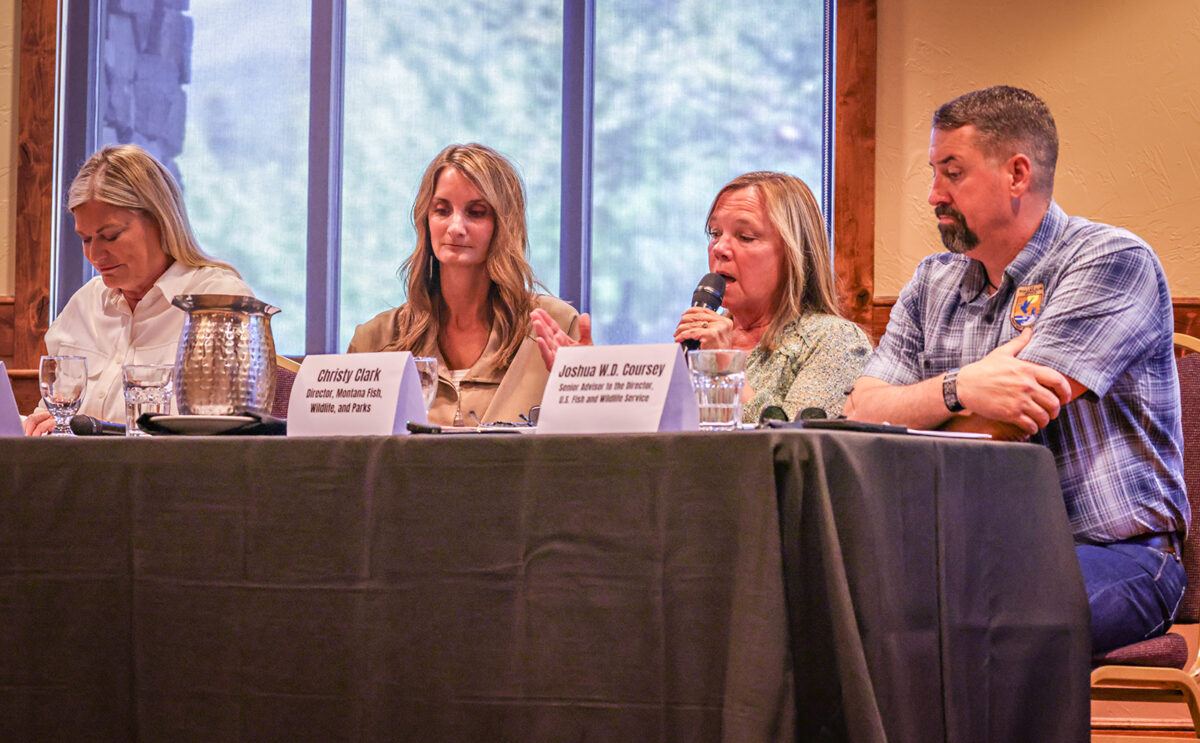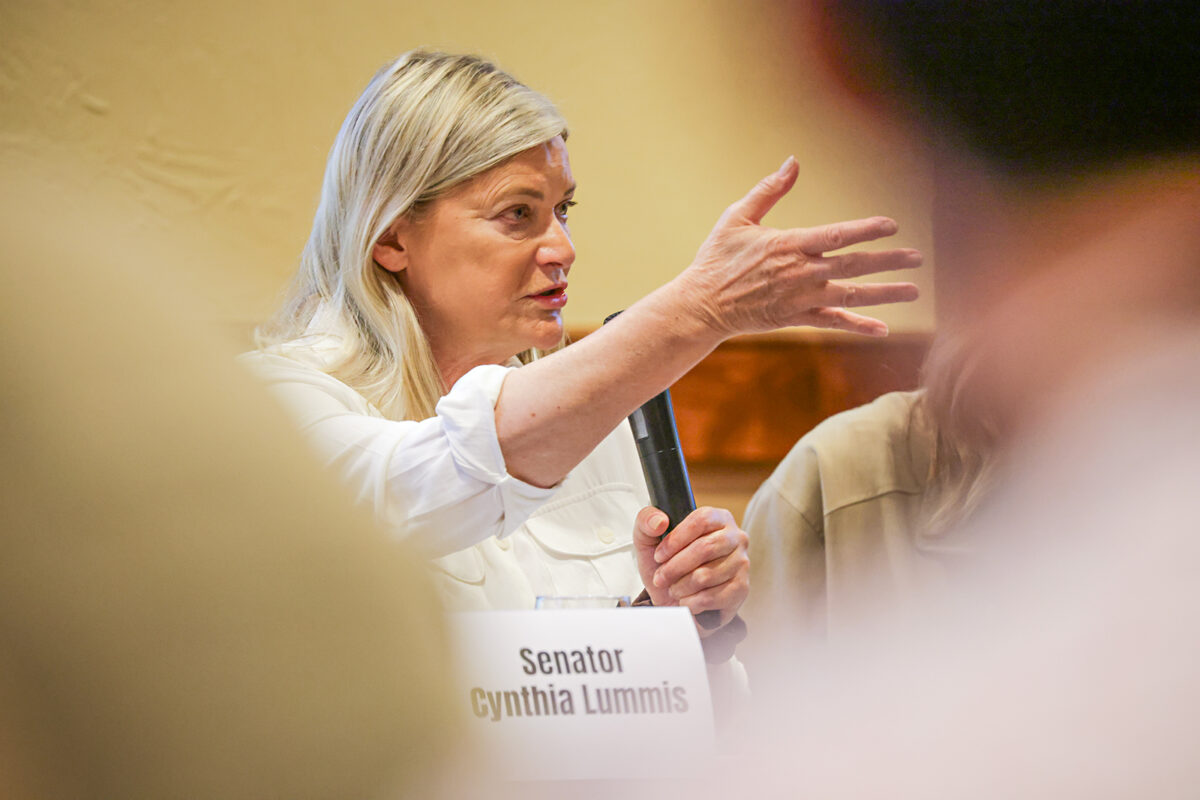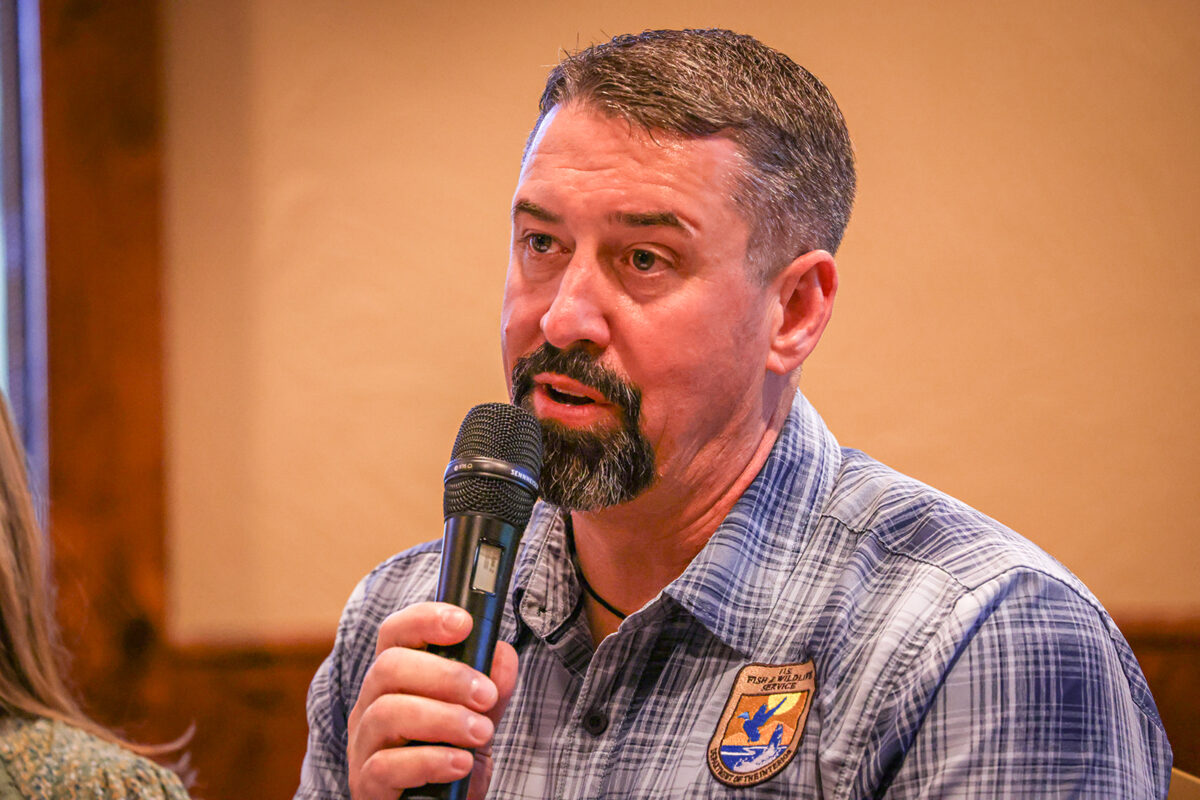FWP Director Says Montana is ‘Ready’ to Delist the Grizzly During Panel Discussion at Western Caucus Policy Summit
The Flathead Valley is hosting a slew of congressional members, Trump administration officials and interested parties as part of the annual policy summit, which features field tours, panel discussions and briefings for the attendees.
By Mariah Thomas
Christy Clark’s favorite topic is grizzly bears.
Clark, the director of Montana’s Fish, Wildlife, and Parks (FWP), is a fifth-generation rancher who grew up on the Rocky Mountain Front and dealt with grizzly bears on her property. But when she was young, she said bears mostly stayed out of her way. By 1995, when she had children of her own on her Choteau ranch, a high-density population of bears meant conflicts with humans.
“Both my sons have been charged,” she said Tuesday. “So many livestock losses, and we worked well with FWP and we worked well with the service. We stayed in those lines, and we stayed in those lines because we kept getting promised, ‘if you follow these rules, we will get to delisting.’”

Flash forward to 2025, and grizzly bears remain on the list of species protected under the Endangered Species Act (ESA). They’ve been on it since 1975. In January, the U.S. Fish and Wildlife Service rejected a petition from Montana’s and Wyoming’s state governments to delist the bears in their recovery zones. Instead, the U.S. Fish and Wildlife Service established a single distinct population segment in Idaho, Montana, Washington and Wyoming, where the bears retain threatened status under the ESA.
It wasn’t the first time people have advocated for the grizzly’s delisting. Other attempts to remove the bear from its ESA-protected status took place in 2007 and 2017 but were blocked by federal courts.
But grizzly bear deaths and conflicts have been on the rise. In response, Clark’s agency shifted its messaging about bear-human conflicts, focusing on the impact of such conflicts on humans, rather than bears.
“We’ve had over 61 conflicts by midsummer and 20 of those were direct human conflicts with charging, and so we’re ready in Montana,” Clark said. “We’re ready to delist. We’re ready for state management, whatever that looks like.”
On Tuesday, she sat on a panel that advocated for the bears’ removal from protected status under the ESA. It’s a position in line with Montana’s congressional delegation, who are cosponsors to a bill in the U.S. House Committee on Natural Resources aiming to delist Yellowstone grizzlies. More than 50 organizations, most of them focused on wildlife, urged Congress to kill the bill.
“I’ll tell you that in Montana, we love seeing grizzly bears on the landscape,” Clark said. “We’re really proud of that. We just have too many bears, and now we have too many bear conflicts, and so we need to find a solution that allows people to recreate, protect their livestock and allow us to manage those high-density populations where there’s so much conflict.”
Clark made her comments at the Western Caucus Policy Summit, an annual event for members of the Congressional Western Caucus, a group of 90 Republican members of the U.S. House. Both of Montana’s congressmen, Reps. Ryan Zinke and Troy Downing, are members.
The summit, which goes Aug. 18-21, includes field tours, small business visits, panel discussions and briefings for caucus members and members of the Trump administration in attendance. This year, the Flathead Valley has played host for the summit. Attendees descended on the Lodge at Whitefish Lake and ventured into Glacier National Park as part of the programming.
The event is hosted by the Western Caucus Foundation, which is co-chaired by Wyoming Sen. Cynthia Lummis and California Rep. Doug LaMalfa. While the foundation is separate from the caucus, it works toward similar goals, aiming to educate policy makers and the public on “Western ideals,” which its website says include individual and private property rights, strong state governmental influence and economic growth.
Clark’s comments came as part of a panel discussion focused on the Endangered Species Act. She was joined on the panel by Sen. Lummis; Angi Bruce, the director of Wyoming’s Game and Fish Department; and Joshua W.D. Coursey, a senior advisor to the director of the U.S. Fish and Wildlife Service.
Her fellow panelists agreed with her presentation of the grizzly bear issue, and used it as an example of the tonal shift they think the new presidential administration needs to take when it comes to the ESA and species recovery.
Lummis highlighted a measure she’s championing to rename the Endangered Species Act to the Endangered Species Recovery Act — a symbolic move that she said would better reflect the law’s intent. All the panelists said the grizzly has made a comeback since it was first designated as endangered. Coursey argued grizzlies have expanded their population since they were first protected by the Endangered Species Act in 1975.

According to estimates, today there are an estimated 2,000 grizzlies in two core populations in the northern Rockies — the Northern Continental Divide Ecosystem and the Greater Yellowstone Ecosystem — up from a figure of 800 in the late 1900s. Grizzlies were wiped out in the late 19th and early 20th centuries. Between 50,000 to 100,000 bears were victims of unregulated killing, bounties, habitat destruction and fragmentation.
“This should be the poster child of the ESA,” Coursey said. “There’s no doubt about it. As we see these grizzly bears expand their population, that is a sign of their carrying capacity being met and continuing to move outward because of the landscape that this incredible beast dominates. This is beyond meeting its population objective. It is fully recovered, and we are working to provide durability to that moving forward to have this delisted.”

The panel’s discussion also touched on litigation and the at-times contentious relationship that exists between humans and wildlife, with panelists arguing that conservation doesn’t mean animals can “overtake” the landscape.
The Tuesday panel was part of a slate of events that also included comments from U.S. Forest Service Chief Tom Schultz and a panel discussion on federal land and resources policy from Trump administration officials.
Speakers touched on a range of issues pertinent to the West, from wildfire management and the importance of prevention to the long process for providing permits for natural resource extraction.
The summit continues into Wednesday afternoon, with comments from Glacier National Park superintendent Dave Roemer about the Great American Outdoors Act, and a panel examining the state-federal partnership in public lands management. Montana Rep. Zinke will sit on Wednesday’s panel.